
Emilio Aguinaldo y Famy was a Filipino revolutionary, statesman, and military leader who is the youngest president of the Philippines (1899–1901) and became the first president of the Philippines and of an Asian constitutional republic. He led the Philippine forces first against Spain in the Philippine Revolution (1896–1898), then in the Spanish–American War (1898), and finally against the United States during the Philippine–American War (1899–1901).

The Philippine Scouts (Filipino: Maghahanap ng Pilipinas/Hukbong Maghahanap ng Pilipinas) was a military organization of the United States Army from 1901 until after the end of World War II. These troops were generally Filipinos and Filipino-Americans assigned to the United States Army Philippine Department, under the command of American commissioned officers (though a handful of Filipino Americans received commissions from the United States Military Academy). Philippine Scout units were given the suffix "(PS)", to distinguish them from other U.S. Army units.
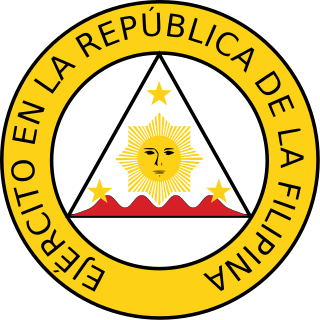
The Philippine Revolutionary Army, later renamed Philippine Republican Army, was the official armed forces of the First Philippine Republic from its formation in March of 1897 to its dissolution in November of 1899 in favor of guerilla operations in the Philippine–American War.
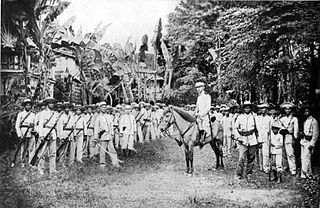
The Battle of Tirad Pass, sometimes referred to as the "Philippine Thermopylae", took place during the Philippine–American War on December 2, 1899, in northern Luzon in the Philippines. A 60-man Filipino rear guard commanded by Brigadier General Gregorio del Pilar succumbed to more than 500 Americans, mostly of the 33rd Volunteer Infantry Regiment under Major Peyton C. March, while delaying the American advance to ensure that President Emilio Aguinaldo and his troops escaped.

Gregorio Hilario del Pilar y Sempio was a Filipino general of the Philippine Revolutionary Army during the Philippine–American War.

Miguel Malvar y Carpio was a Filipino general who served during the Philippine Revolution and, subsequently, during the Philippine–American War. He assumed command of the Philippine revolutionary forces during the latter, following the capture of resistance leader Emilio Aguinaldo by the Americans in 1901. According to some, he could have been listed as one of the presidents of the Philippines; however, as of 2023, is not recognized as such by the Philippine government.

Antonio Narciso Luna de San Pedro y Novicio Ancheta was a Filipino pharmacist and army general who fought in the Philippine–American War before his assassination on June 5, 1899 at the age of 32.
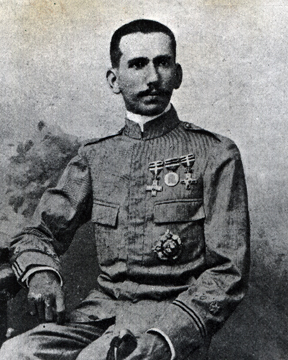
José Torres Bugallón y Gonzales was a Filipino military officer who fought and served the Spanish Government during the Philippine Revolution against the revolutionaries and joins the Philippine Revolutionary Army during the Philippine–American War. He is known as the "Hero of the Battle of La Loma", where he was fatally wounded that led to his death.

The battle of Caloocan was one of the opening engagements of the Philippine–American War, and was fought between a U.S. force under the command of Arthur MacArthur Jr. and Filipino defenders commanded by Antonio Luna in 1899. American troops launched a successful attack on the Filipino-held settlement of Caloocan on February 10, which was part of an offensive planned by MacArthur Jr. Coming soon after an American victory near Manila just a few days prior, the battle once again demonstrated the military superiority enjoyed by U.S. forces over Filipino troops, yet it was not the decisive strike that MacArthur had hoped for, and the war continued to rage on for another three years.

Fighting erupted between forces of the United States and those of the Philippine Republic on February 4, 1899, in what became known as the 1899 Battle of Manila. On June 2, 1899, the First Philippine Republic officially declared war against the United States. The war officially ended on July 2, 1902, with a victory for the United States. However, some Philippine groups—led by veterans of the Katipunan, a Philippine revolutionary society—continued to battle the American forces for several more years. Among those leaders was General Macario Sakay, a veteran Katipunan member who assumed the presidency of the proclaimed Tagalog Republic, formed in 1902 after the capture of President Emilio Aguinaldo. Other groups, including the Moro, Bicol and Pulahan peoples, continued hostilities in remote areas and islands, until their final defeat at the Battle of Bud Bagsak on June 15, 1913.

The Battle of Marilao River was fought on March 27, 1899, in Marilao, Bulacan, Philippines, during the Philippine–American War. It was one of the most celebrated river crossings of the whole war, wherein American forces crossed the Marilao River, which was 80 yards (73 m) wide and too deep to ford, while under Filipino fire from the opposite bank.
The following lists events that happened during 1899 in the Philippine Republic.

José Cándido Alejandrino y Magdangal was a Philippine Republican Army general during the Philippine Revolution and the Philippine–American War.

Pedro Tongio Liongson was a member of the Malolos Congress which wrote the constitution of the First Philippine Republic in 1899 and served as First Director of Military Justice in the Republic's army during the Philippine–American War of 1899–1901. A trained lawyer and judge, Col. Liongson figured in and left his mark on a number of historic events in the Philippines.

The Capture of Malolos, also known as the Battle of Malolos, occurred on March 31, 1899, in Malolos, Bulacan, during the Philippine–American War. General Arthur MacArthur Jr.'s division advanced to Malolos along the Manila-Dagupan Railway. By March 30, American forces were advancing toward Malolos. Meanwhile, the Aguinaldo government moved its seat from Malolos to San Isidro, Nueva Ecija.
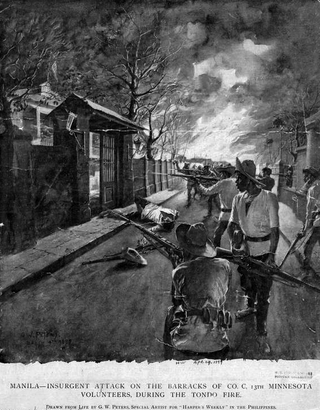
The Second Battle of Caloocan, alternately called the Second Battle of Manila, was fought from February 22 to 24, 1899, in Caloocan during the Philippine–American War. The battle featured a Filipino counterattack aimed at gaining Manila from the Americans. This counterattack failed to regain Manila mainly because of lack of coordination among Filipino units and lack of artillery support.
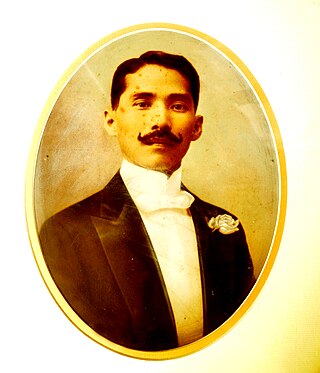
Benito Alejandrino Natividad was a military leader, a governor and a judge. His parents were Gervasia Alejandrino and Mamerto Natividad, Sr. a lawyer and the First Martyr of Nueva Ecija who was executed by the Spanish authorities on Sept. 26, 1896 in San Isidro, Nueva Ecija. He fought in the Philippine Revolution against Spain and was exiled to Hong Kong with Aguinaldo and other revolutionaries in accordance with the Treaty of Biak Na Bato. He also fought in the Philippine–American War and was one of the last to surrender together with Gen. Manuel Tinio, after the capture of Aguinaldo. He was wounded twice in battle.

FranciscoRomán y Velasquez was a Spanish Filipino soldier and later became a revolutionary during Philippine Revolution and Philippine–American War. Roman had the rank of a colonel in the revolutionary army, and served as the close aide of General Antonio Luna. When Luna was assassinated in Cabanatuan, Nueva Ecija, Román attempted to save him but he was also shot to death by Emilio Aguinaldo's presidential guards.

Goyo: The Boy General, or simply Goyo, is a 2018 Filipino epic war film starring Paulo Avelino as the titular "Boy General", Gregorio del Pilar, who fought and died at the Battle of Tirad Pass during the Philippine–American War. It was written, directed, edited, and scored by Jerrold Tarog, and is a sequel to the 2015 film Heneral Luna, which chronicled Antonio Luna's life. Additional members of the ensemble cast include Carlo Aquino, Mon Confiado, Epy Quizon, Gwen Zamora, Empress Schuck, Alvin Anson, and Rafa Siguion-Reyna. It was released on September 5, 2018.
Pampanga in the Philippine Revolution remained almost wholly loyal to Spanish suzerainty, with only few noble Kapampangan families defecting to the Katipunan. Kapampangan involvement in defending Spanish interests began when the Revolution broke out, with many freemen enlisting in Spanish forces. However, Tagalog rebels would eventually infiltrate the province and begin a campaign of terrorism. Once Spain lost the Battle of Manila Bay, Spanish forces in Pampanga retreated to Macabebe and awaited their return to Spain. Republican forces would raze and loot Kapampangan towns for their cooperation with Spanish forces. To revenge their losses, many Kapampangans would enlist with the Americans to defeat the Philippine Republic.



















